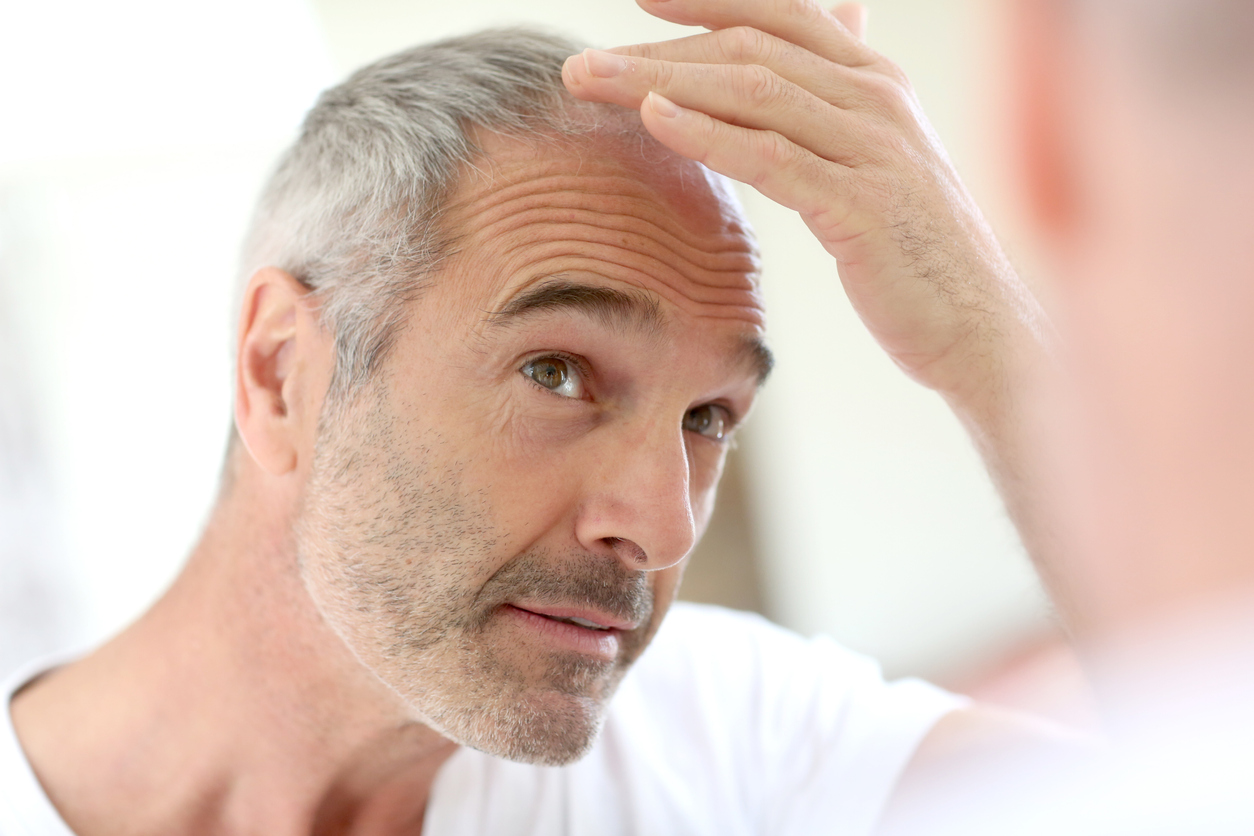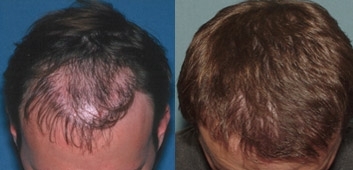
Thinning hair, receding hairlines, and sunburned scalps are common issues patients say bring them to our office for consultation. Many people have noted gradual changes to their hair and receding hairlines, while others feel like what they are experiencing has developed overnight. So, most patients want to know why this is happening and what can be done to stop it. During your consultation here at the Alabama Hair Institute with one of our doctors, your concerns are addressed at length. The Alabama Hair Institute doctors, Dr. Austin Adams and Dr. Daniel Rousso, can provide insight about your problem and offer the best treatment options to provide you with very natural-looking results.

Androgenetic Alopecia
The number one cause of hair loss in both men and women is called androgenetic alopecia (AGA), which is a genetic condition that can lead to male pattern baldness and female pattern hair loss. AGA is progressive and leads to permanent hair loss in the areas sensitive to Dihydrotestosterone (DHT), the hormone responsible for this hair loss. In women, while we know that hormones play a vital role in female pattern hair loss, the role of DHT is not as well understood.
Aging
Like wrinkles and sagging skin, hair loss is a common side effect of aging in both men and women. Men in their 50s can expect a 50 percent chance of hair loss. However, some people may assume their hair loss is due to aging when it could be caused by hormones, medications, or other physical conditions. Identifying the real cause of hair loss can ensure that treatment will be more effective.
Hormones
Changes in hormones affect hair growth and can lead to hair loss. Hormone-related hair loss is more common in women and can occur with pregnancy, menopause, polycystic ovary syndrome, and other hormone shifts. Rebalancing your hormone levels typically restores normal hair growth.
Medications
Certain medications can cause hair loss. Common examples include blood thinners, antidepressants, cholesterol medications, anti-inflammatories, oral contraceptives, blood pressure medications, and seizure medications. Asking your doctor if you can switch to another medication may allow you to continue getting the health treatment you need while stopping your hair loss.
Health Conditions
A variety of health conditions can cause hair loss. Some of these include alopecia areata, hypothyroidism, anemia, lupus, trichotillomania, loose-anagen syndrome, and scalp infections. Effective treatment can either stop hair loss or provide hair restoration in the case of permanent hair loss.
Lifestyle Causes
Your lifestyle could be contributing to your hair loss. Extreme, long-term stress, nutritional imbalances, including crash dieting, can lead to hair loss. Chemicals used in dyeing hair repeatedly can weaken the hair shaft leading to hair thinning. Also, hairstyles that pull the hair tight for long periods of time will also cause the hair to thin and result in permanent hair loss due to trauma of the hair shaft.
Getting Treatment for Hair Loss
When you see the first signs that your hair is thinning, you should attempt to identify the cause. Talk with your doctor and develop a plan to determine whether making changes to your lifestyle, adjusting medications, or receiving treatment for hormonal imbalances or other health issues will resolve hair loss. The next step is to look into hair restoration treatments. Your treatment options include:
- Rogaine® (minoxidil): Rogaine® is a topical medication that can treat AGA in both men and women. Rogaine is a general hair stimulant when applied to the scalp. With continued treatment, Rogaine® can regrow some hair. It can also be used in combination with hair restoration surgery to maximize results.
- Propecia® (finasteride), for men only: Propecia® is a prescription oral medication that can stop male pattern hair loss. Propecia works by blocking the conversion of testosterone to Dihydrotestosterone (DHT). DHT is the hormone responsible for causing male pattern alopecia. DHT also causes men to grow hair on their backs and causes prostate gland enlargement. It must be taken every day and can be used in combination with hair restoration surgery to maximize potential results.
- Platelet-Rich Plasma (PRP): PRP is derived from your red blood cells and can be injected into the scalp. Rich with growth factors, PRP can stimulate hair growth and is often used in patients just beginning to lose their hair. PRP may also be used in combination with hair restoration surgery.
- Low-Level Laser Light Therapy: Low-Level Laser Light therapy stimulates hair follicle cells and improves their function to boost healthy hair growth. This is an in-home treatment that produces noticeable results after 12 weeks. This can be combined with either PRP or hair transplantation surgery.
- Follicular Unit Transplantation (FUT) Surgery: FUT surgery restores hair by extracting a strip of tissue from the back or sides of the scalp and dividing it into grafts. The hair grafts are then placed into thinning or balding areas to restore hair fullness. FUT may be repeated every six to 12 months as desired.
- NeoGraft® Follicular Unit Excision (FUE) Surgery: NeoGraft® FUE surgery restores hair by punch removal of hair grafts from the back or sides of the head into a collection canister. This minimally invasive approach allows the grafts to be easily extracted and transplanted to thinning or balding areas. Patients will have no linear scarring and no sutures. FUE may be repeated every six to 12 months as desired.
Losing your hair can be deeply depressing. The Alabama Hair Institute can provide the treatment you need to restore natural-looking, youthful hair. To request your personal consultation with Dr. Rousso or Dr. Adams, call us at (205) 930-9595 or toll-free at (877) 932-0400 today. You may also contact us online at your convenience, and we will get back to you right away.


